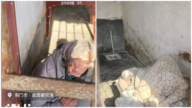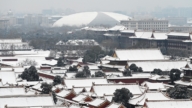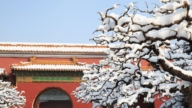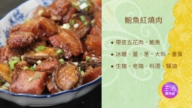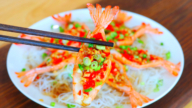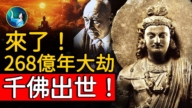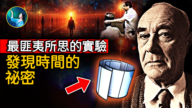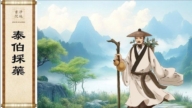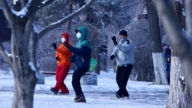【新唐人2013年06月01日讯】中国大陆原《新华社》记者,现任《炎黄春秋》杂志副社长的杨继绳,最近他的著作《墓碑》一书,获得美国“海耶克奖”。这本书揭露﹕中国“三年大饥荒”,是源自于共产党的人祸,而不是天灾。5月29号晚间,杨继绳在纽约参加了颁奖活动和座谈。他在座谈中表示,书名《墓碑》,不仅是纪念死去的3千6百万人,也希望“埋葬”造成悲剧的这个中共体制。
美国曼哈顿研究所(Manhattan Institute)为纪念海耶克设立的这个图书奖,主旨在于恢复人们被侵蚀的思想自由。2012年得主——美国财政部前副部长泰勒(John B. Taylor)认为,《墓碑》应该成为美国学校必选读物,也应该成为中国学校的必读作品。
获得诺贝尔经济学奖的海耶克曾经说过,“经济学的难题是让人们明白,他们以为自己可以设计一个系统,其实是多么无知。”
而杨继绳通过阅读海耶克,对大饥荒的本质及原因有了更深刻的认识。
杨继绳的父亲在中国大饥荒年代,活活被饿死,当时他正在就读中学。他说,他的这本书,是给父亲和所有饥荒中饿死的中国人立下的“墓碑”。
从20世纪90年代开始,杨继绳利用到中国各地采访的机会,查阅各地有关饥荒的资料,访谈经历过大饥荒的民众。
经过十年的努力,他收集了十几个省、上百名当事人、上千万字的资料,终于比较全面和深入的了解大饥荒的真实情况。他的结论是:天灾年年有,但那三、四年却是正常的年景。
杨继绳参照中外多方面资料,确认﹕从1958年到1962年期间,中国饿死3600万人。因饥饿使得出生率降低,少出生人数为4000万人。共计为7600万人。
饿死3600万人是一个什么样的概念?这个数字相当于1976年7月28号唐山大地震死亡人数的150倍。也可以说,大饥荒相当于发生了150次唐山大地震。这个数字超出了第一次世界大战的死亡数字。
而杨继绳在书中描述说,玉米心吃光了,野菜吃光了,树皮吃光了,鸟粪、老鼠、棉絮都用来填肚子。在挖观音土的地方,饥民们一边挖,一边大把大把的往自己嘴里塞土。死人的尸体,外来的饥民,甚至自己的亲人,都成了充饥的食品。那时,“人相食”不是个别现象,古籍记载“易子而食”,在大饥荒年代,吃亲生儿女的事件就有多起。
大陆作家铁流是杨继绳的好友,他祝贺杨继绳的作品获奖。
大陆作家铁流:“杨继绳得奖,应该得。把这个历史记录下来。中共现在还不认账。前一段时间中共社科院副院长李慎明,说三年饿死三千万是刻意编造的谎言,是往共产党脸上抹黑。杨继绳的书,那是历史活生生的历史,任何人否定不了。”
铁流表示,从1959到1962年,他的老家四川省就饿死了1250万人,包括他的母亲和叔叔。铁流说,四川的荥经县,是当时饿死人最严重的一个县。这个只有12万人口的小县,却饿死了6万多人。
铁流:“我的母亲是饿死的。当时我们当右派在沙坪农场。沙坪农场有一万多右派,饿死了五千多人。好多人饿死在我身边。夹边沟是3200多右派,饿死了2500多人。我们是经历者,眼见者,目击者,知道这个血腥历史。毛泽东是反人类罪。共产党欠下人民活生生的血债。”
《九评共产党》在第七篇中写道,1959年庐山会议,为民请命的彭德怀遭到整肃,一大批敢于说出实话的干部被撤职、关押、审查,到大饥荒发生时已经无人敢说真话,几乎全都为了保住自己的乌纱帽,而掩盖饿死人的真相,甚至甘肃省在陕西主动提出支援他们粮食时,还以粮多得吃不了为借口拒绝了。
杨继绳表示,希望人们汲取教训,这样才能远离黑暗,远离悲剧,不让它们重演。
采访编辑/秦雪 后制/周天
Yang Jisheng Awarded 2013 Hayek Prize for “Tombstone” ´
Yang Jisheng, ex-journalist and currently vice president
with Yanhuang Chunqiu magazine, recently received the
Manhattan Institute’s Hayek Prize for his book, “Tombstone”.
This book reveals that the “three-year great famine”
was actually created by the Chinese Communist Party (CCP),
instead of it being, as some have said, a natural disaster.
On May 29, Yang Jisheng attended the awards ceremony
and a discussion held in New York.
He said that the book title, Tombstone, is a memorial to
36 million Chinese who starved to death.
Also, it is his hope for burying the CCP,
the perpetrator of the tragedy.
US-based Manhattan Institute set up the Hayek Prize,
with the aim of restoring people´s freedom of thought,
that has been repressed.
John Taylor, the 2012 winner and former U.S. Treasury
Deputy Minister, has suggested that
“Tombstone” should be listed as a required reading book
in American and Chinese schools.
Friedrich Hayek, Nobel Prize winning economist,
once said that “The curious task of economics is
to demonstrate to men how little they really know
about what they imagine they can design.”
Reading through Hayek´s book, Yang Jisheng gained
more insight on the nature and cause of that “famine”.
Yang Jisheng´s father was starved to death in the famine
when Yang was a middle school student.
Yang said that this book is a tombstone that
he erects for his father and for all others who were
starved to death during that period.
Yang Jisheng began his investigation into
the “famine” in the 1990s.
During his nationwide travels, Yang consulted relevant data,
and interviewed local survivors of the famine.
After a decade of effort, Yang collected data involving
hundreds of people in over a dozen provinces.
He could get quite a comprehensive picture of
the truth of the famine.
He concluded that there could be natural disasters yearly,
however the famine was happened during the ordinary years.
By referring to a wide variety of data, Yang confirmed that
36 million Chinese were starved to death in period 1958-1962.
Hunger decreased the birth rate and
caused 40 million fewer births.
The death toll of 36 million is 150 times the sum of death
on the 1976 Tangshan earthquake.
This figure exceeds the total number of
deaths in World War I.
The book related that in those days, the starved people
ate nearly everything including corncobs, tree barks.
Even bird droppings, mice, cotton and
earth became their foods.
The bodies of the dead, famine refugees from other regions,
and even their family members, all became people´s food.
During that period, eating people was not isolated and
there occurred many cases of people eating their own children.
China´s writer Tie Liu congratulates Yang Jisheng on
winning the award.
Tie Liu: “Yang Jisheng deserves this award.
He recorded a period of history, which the CCP still negates.
Recently, Li Shenming, vice president of
the Chinese Academy of Social Sciences,
alleged that the starvation of 30 million people
is a fabrication, an act of discrediting the CCP.
Yang´s book is a definitive history of the famine,
no one can deny it.”
Tie Liu says that from 1959 to 1962, in Sichuan,
his hometown, 12.5 million people were starved to death,
including his mother and his uncle.
Tie Liu reveals that Sichuan´s Yingjing County
had the highest death toll.
In this small county with a population of 120,000,
over 60,000 people were starved to death.
Tie Liu: “My mother was starved to death.
At that time I was officially censured as a rightist,
and exiled to Shaping Farm.
This farm held over 10,000 rightists, over half of
them died from starvation, I witnessed many deaths.
In Jiabian Gou, another forced-labor camp in Gansu,
over 2,500 of 3,200 rightists detainees starved to death.
We were witnesses; we´ve lived through that period,
we know the truth of this bloody history.
Mao Zedong committed crimes against humanity.
The CCP owes the Chinese people a blood debt.”
The book, Nine Commentaries on the Communist Party,
records the CCP´s history of killing in Commentary 7.
It states that after the CCP´s Lushan Plenum held in 1959,
General Peng Dehuai was stripped of his power
for speaking out for the people.
A group of truth-telling officials and cadres were all
removed from their posts, detained, or investigated.
When the deaths from starvation occurred nationwide,
no official dared to speak out on the truth.
Gansu Province even refused food aid from Shaanxi Province,
claiming that Gansu had too much food surplus.
Yang Jisheng hopes that the Chinese people can
learn some lessons from this tragedy, to prevent it from ever happening again!









